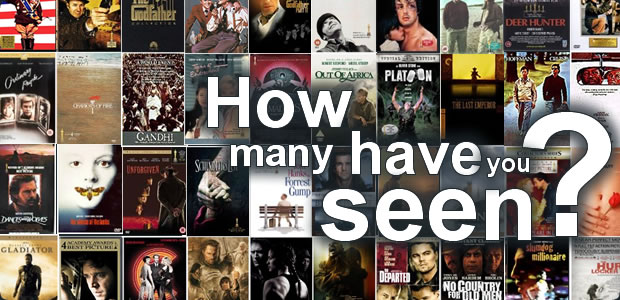
So, why did I spend more than two years watching movies awarded by an unreliable, self-righteous cinematic cult? Well…
I think the marathon was a chance for me to evaluate what’s still seen as an authority on best-of-year movies (at least with respect to British/American cinema). Is the Academy truly irrelevant to cinema’s ultimate legacy?
But I also wanted the chance to review a treasure trove of film classics I had never seen before: films like All Quiet on the Western Front, Gone with the Wind, The Best Years of Our Lives, On the Waterfront, Lawrence of Arabia, Annie Hall, and Unforgiven. These are films that, regardless of my or anyone else’s opinion about them, will continue to be discussed and debated as long as we talk seriously about movies. I knew I’d also have a chance to revisit films I hadn’t seen in a while, like Casablanca, The Deer Hunter, and Titanic. I wanted to watch each movie fresh, give it a chance to defy or confirm my original opinion. Because it’s amazing how time changes the movies, and ourselves.
As you’ve seen, my format for the “mini-reviews” (as I termed them back in the day) changed as the films went on. My reviews for the late 1920s/early 1930s films quickly ballooned in terms of verbosity, my word count increasing just as my investment in these films did. In retrospect, I find my (often futile) attempts at cutting the wordage rather amusing: do any two films warrant the same exact word count?
But I digress. When I started this countdown back in July 2012, I asked myself a series of questions: which films hold up? Which films don’t? Which films deserve only to be handled with a shovel?
Well, to the first question: a majority! By that I mean, in my humble opinion, the majority of Best Pictures are well worth your time and investment. I was especially surprised by how many older films (let’s say pre-1970) I found enjoyable or insightful even by today’s standards. I saw how much seafaring adventures owe to Mutiny on the Bounty, an impressive seafaring adventure in its own right. I discovered how romantic comedies could succeed on the strength of their characters and situational humor in films like It Happened One Night and The Apartment. I even enjoyed a few musical films (far from my favorite genre) like West Side Story and The Sound of Music. It helps that these films have characters we care about, in addition to their grandly choreographed musical numbers.
As for how many of them warrant the title of “Best Picture” (or eliminating the superlative: “Great Picture”)? That’s a significantly lower number. But I’ll name a few. Movies like All About Eve, Midnight Cowboy, The Godfather, Amadeus, and No Country for Old Men retain their excellence because every element of their construction is working at the highest level: from dialogue and cinematography, to acting and direction, to production and sound design. They don’t just represent some of the best cinema; they represent the full potential of the cinematic medium.
Of course, we’re going to get the bad with the good. Quite a few of these movies may have wormed themselves into the Academy’s heart thanks to topical isues explored therein. It’s no wonder a film like Casablanca, with its memorable dialogue and characters, stands the test of time while a bland, call-to-action propaganda piece like Mrs. Miniver falls by the wayside. Both films addressed the WWII zeitgiest of the early 1940s, but chose to approach those concerns in contrasting ways.
I’ve also seen a few films that felt like the safe choice, especially in a sea of far worthier nominees. John Ford’s How Green Was My Valley was a decent (if unfocused) account of a Welsh coal mining village, but it’s rather amazing to think it beat out Orson Welles’s Citizen Kane from the same year. This probably has less to do with the perception of the films at the time than it does with the controversy Citizen Kane caused at the time. It was accused of slandering media magnate William Randolph Hearst, and thus was unfairly demeaned.
What I will say about the films I didn’t care for is this: I thank heavens none of them were terrible. Bad, yes, but never unwatchable. Even the silliest of Best Pictures were handsomely mounted and staged, with most of my issues stemming from the content of the film rather than the production value. There’s a secret part of me that wanted at least one “so bad it’s good” film (Cavalcade had its moments, but lacked consistency). Ah well. I did a marathon of “Best” Pictures, so what did I expect?
The Academy is a fickle bunch, and seldom a guidepost for cinematic benchmarks. But they’re just one opinion. I’ve made my own, and I hope you’ll do the same, dear reader. I won’t encourage you to do what I did (unless you’d really like to), but dare to look beyond the Academy stamp of approval. You’ll probably see something they missed.
Next up: OBPC WRAP-UP (Part 2 of 4): Special and Miscellaneous Awards!